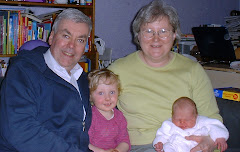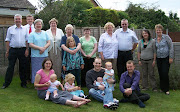I am still reading 'Jesus through Middle Eastern Eyes' by Kenneth Bailey. In chapter 28 he reflects on what he calls the 'parable of the compassionate employer'(Matthew 20:1-16). He reminds the readers that this is another parable which has a 'missing ending'( like the parable of the Prodigal Son).
He suggests that the parable reaches a "critical dramatic moment and stops".
"What is the response of the workers who are complaining? We are not told. The readers/listeners are challenged to find themselves in the story and to bring it to an appropriate conclusion in their own lives.
A summary of the parable might be - He comes to us where we live; He loves us as we are."
"Once more Jesus creates a ‘house’ in which readers/listeners are invited to take residence as they make the worldview of the parable their own."
Thursday, 30 April 2009
Friday, 24 April 2009
webcam

I recently bought an inexpensive webcam and can now enjoy a video call with my grandchildren. Although it has to be said that speaking to grampa via Skype takes second place to watching High School Musical 3.
The webcam picture really highlights my eyebrows which were recently described as "Alistair Darling like". But at the least the background bookshelves look reasonably impressive and almost tidy.
Wednesday, 22 April 2009
Healthy churches
I am just about to begin a series based on the 'Seven marks of a Healthy Church' as described in the Healthy Churches' Handbook.
One of the issues raised is about how we understand 'church'. The book describes the response of Archbishop Rowan Williams who, when asked what his definition of church was, replied along the lines of: 'church is what happens when the impact of Christ on a situation brings two or more people together'. The book points out this this is a surprising definition because of what it leaves out( no mention of sacraments, Word, building, worship and much else). But what is our mental image of 'church' and how would we express it? The suggestion in this book is that 'Church = community + faith + action'( or to put it another way, 'an engaging faith community').
The book also suggests at one point one of those exercises where people are encouraged to try and describe their local church in terms of an animal or object or colour.
(e.g. our church is like an elephant: it never forgets, is very slow to move and very unpredictable as to which direction it might take when it does move - or our church is like a sheep dog: it is well disciplined, barks a lot and most enjoys trying to get everyone to go where it wants them to go' - or 'our church is like a wheelbarrow: nothing moves unless you push it'.)
I will need to ponder how I would describe our church!
One of the issues raised is about how we understand 'church'. The book describes the response of Archbishop Rowan Williams who, when asked what his definition of church was, replied along the lines of: 'church is what happens when the impact of Christ on a situation brings two or more people together'. The book points out this this is a surprising definition because of what it leaves out( no mention of sacraments, Word, building, worship and much else). But what is our mental image of 'church' and how would we express it? The suggestion in this book is that 'Church = community + faith + action'( or to put it another way, 'an engaging faith community').
The book also suggests at one point one of those exercises where people are encouraged to try and describe their local church in terms of an animal or object or colour.
(e.g. our church is like an elephant: it never forgets, is very slow to move and very unpredictable as to which direction it might take when it does move - or our church is like a sheep dog: it is well disciplined, barks a lot and most enjoys trying to get everyone to go where it wants them to go' - or 'our church is like a wheelbarrow: nothing moves unless you push it'.)
I will need to ponder how I would describe our church!
Saturday, 4 April 2009
Courageous women
Some more thoughts from Kenneth E Bailey's book, 'Jesus through Middle Eastern eyes'.
In Chapter 19 he reflects on the parable of the widow and the judge( Luke 18:1-8). He notes that the hero of the parable is a woman of courage and persistence. He ends the chapter with a brief paragraph looking ahead towards the Cross.
"...as the cross approached, the role of the women in the band of disciples became more prominent. A woman anointed the Messiah as he approached the end. Women were faithful to the end at the cross. They had the courage to follow Joseph of Arimathea as he made his way to Pilate. It was the women who brought the spices to the tomb to anoint the body of Jesus.... who heard the glorious and yet frightening words of the angels. They took the news to the absent disciples.
In like manner in this parable the hero is a woman, a woman with persistence and courage – the very virtues that his female disciples so nobly exhibited all through Holy Week. To them.......the church remains forever in debt."
This week will include daily Holy Week Prayer breakfasts at Harrogate Baptist. I always look forward to this week and to the opportunity to lead the short meditation each morning, even if it means a slightly earlier start to the day!
In Chapter 19 he reflects on the parable of the widow and the judge( Luke 18:1-8). He notes that the hero of the parable is a woman of courage and persistence. He ends the chapter with a brief paragraph looking ahead towards the Cross.
"...as the cross approached, the role of the women in the band of disciples became more prominent. A woman anointed the Messiah as he approached the end. Women were faithful to the end at the cross. They had the courage to follow Joseph of Arimathea as he made his way to Pilate. It was the women who brought the spices to the tomb to anoint the body of Jesus.... who heard the glorious and yet frightening words of the angels. They took the news to the absent disciples.
In like manner in this parable the hero is a woman, a woman with persistence and courage – the very virtues that his female disciples so nobly exhibited all through Holy Week. To them.......the church remains forever in debt."
This week will include daily Holy Week Prayer breakfasts at Harrogate Baptist. I always look forward to this week and to the opportunity to lead the short meditation each morning, even if it means a slightly earlier start to the day!
Wednesday, 1 April 2009
The lady is not for stoning

In his book, Tell it slant', Eugene Peterson recommends Kenneth Bailey's book 'Jesus through Middle Eastern Eyes'. I am just over half way through the book and finding it to be a fascinating read.
This morning I read through the chapter 'The lady is not for stoning' which is Bailey's take on the story of Jesus and the woman caught in the act of adultery(John 7:53-8:11)
He writes:-
“At great cost Jesus has shifted their hostility from her to himself and he doesn't even know her name. The famous servant song of Isaiah affirms, “ with his stripes we are healed”(Isa 53:5). She knows that the opponents of Jesus will be back with a bigger stick and that Jesus is in process of getting hurt because of what he is doing for her. She is the recipient of a costly demonstration of unexpected love that saves her life.Jesus demonstrates the life-changing power of costly love. This scene provides an insight into Jesus’ understanding of the significance of his own suffering. A core aspect of his “doctrine of the atonement” is here displayed….
"Jesus lives out the core meaning of the Cross. He offers the woman a costly demonstration of unexpected love. The reader is obliged to reflect on how the woman in the story may have responded, and in the process think deep thoughts regarding his or her response to the costly love of God offered on the cross for the world."
"Great theological and ethical bells ring in this story and the greatest among them is Jesus interpreting his own cross”.
Would this story serve as a powerful illustration of what was happening on the first Good Friday?
Subscribe to:
Comments (Atom)




